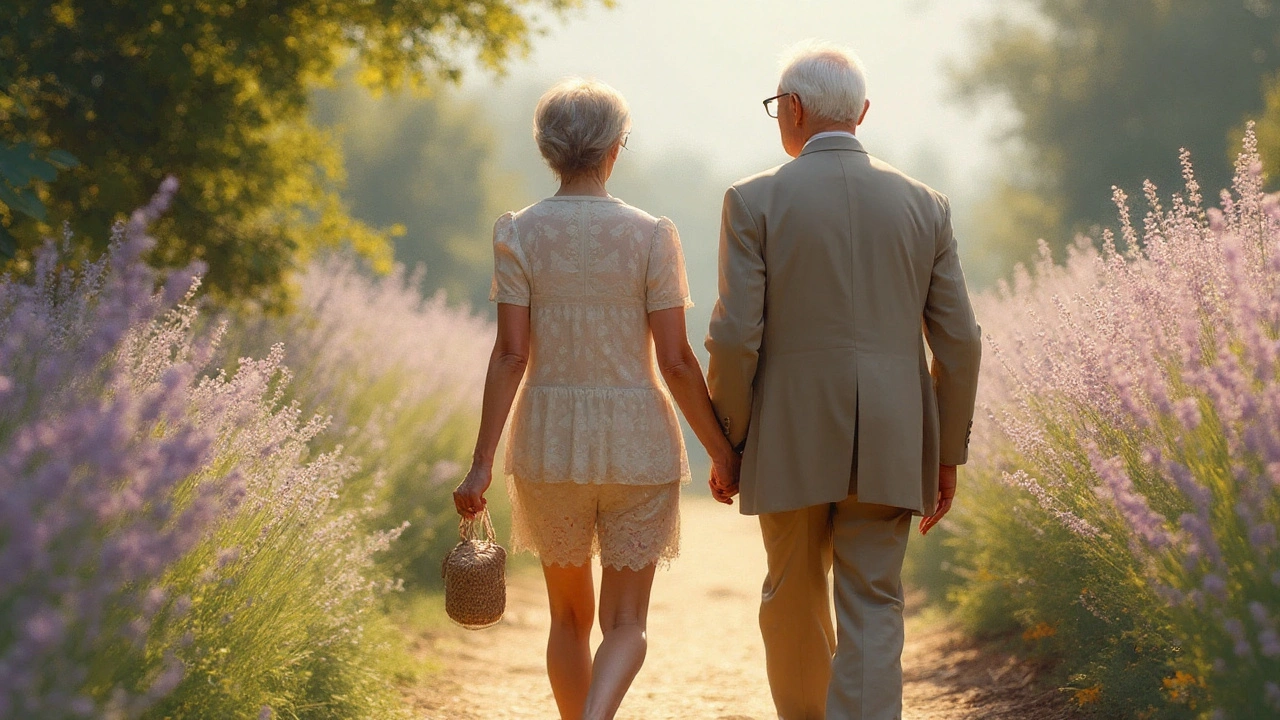Age‑related vision change is a natural decline in visual function that occurs as the eye’s structures age, characterized by reduced clarity, diminished night vision, and slower focusing ability. It affects over 60% of adults after age 50 and is influenced by genetics, lifestyle, and environmental exposure.
What Happens Inside the Eye as You Grow Older?
The eye is a complex system of lenses, nerves, and fluids. With time, the lens becomes less flexible and more opaque (presbyopia and cataract formation). The retina’s photoreceptor cells lose some sensitivity, making it harder to see contrast or read in low light. Meanwhile, the optic nerve may experience pressure buildup, a hallmark of glaucoma a group of diseases that damage the optic nerve, often without obvious symptoms until later stages.
Common Age‑Related Eye Conditions
Four conditions account for most vision loss in people over 50. Understanding each helps you spot warning signs early.
| Condition | Typical Onset | Key Symptoms | Standard Treatment |
|---|---|---|---|
| Cataract clouding of the lens | 60‑70 years | Blurred vision, glare, faded colors | Surgical lens replacement |
| Age‑related macular degeneration (AMD) degeneration of the central retina | 55‑75 years | Distorted lines, central blind spot | Anti‑VEGF injections, lifestyle changes |
| Glaucoma progressive optic‑nerve damage | 40‑70 years | Peripheral vision loss, eye pressure | Eye‑drops, laser therapy, surgery |
| Presbyopia loss of near‑focus ability | 40‑55 years | Reading fatigue, need to hold books farther | Reading glasses, multifocal lenses |
How Lifestyle Choices Influence Vision Aging
Diet, exercise, and eye‑care habits can slow many of the processes listed above. For instance, a diet rich in lutein and zeaxanthin carotenoids that accumulate in the retina has been linked to a 25% lower risk of late‑stage AMD in several longitudinal studies. Similarly, Omega‑3 fatty acids found in fatty fish support tear‑film stability, reducing dry‑eye symptoms that become more common after 50.
Regular aerobic activity improves blood circulation, delivering oxygen and nutrients to the optic nerve. A 2021 Australian cohort study found that people who walked at least 30 minutes five times a week had a 15% reduced incidence of glaucoma compared with sedentary peers.
Daily Practices to Guard Your Eyesight
- Annual comprehensive eye exam - Includes retina imaging, intra‑ocular pressure measurement, and vision acuity testing. Early detection of cataract or AMD can mean simple interventions rather than surgery.
- Wear UV‑blocking sunglasses that filter 99‑100% of UVA and UVB rays whenever you’re outdoors. UV exposure accelerates cataract formation.
- Practice the 20‑20‑20 rule: every 20 minutes, look at something 20 feet away for 20 seconds to reduce digital eye strain.
- Maintain a humid environment indoors or use lubricating eye drops to combat dry eye syndrome a condition where tears evaporate too quickly.
- Limit blue‑light exposure after sunset; switch devices to “night mode” to protect the retina’s photoreceptors.

Nutrition Blueprint for Healthy Aging Eyes
Here’s a simple weekly plan that packs the nutrients your retina craves:
| Food | Key Nutrient | Portion |
|---|---|---|
| Spinach or kale | Lutein & Zeaxanthin | 1 cup cooked |
| Salmon or sardines | Omega‑3 (EPA/DHA) | 150g |
| Egg yolk | Vitamin D & Lutein | 1 large |
| Almonds | Vitamin E | ¼ cup |
| Oranges | Vitamin C | 1 medium |
Combine these foods with a daily multivitamin that includes zinc and copper, minerals shown to support macular health in the Age‑Related Eye Disease Study (AREDS2).
When to Seek Professional Help
If you notice any of the following, schedule an eye‑care appointment promptly:
- Sudden cloudiness or “floaters” that increase in number.
- Gradual loss of peripheral vision, a classic sign of glaucoma.
- Distorted straight lines or a dark spot in the center of your visual field - possible AMD.
- Persistent eye pain, redness, or severe dryness that interferes with daily tasks.
Early intervention can preserve vision and often reduces the need for invasive surgery later on.
Looking Ahead: Emerging Technologies
Researchers are testing gene‑therapy approaches to halt AMD progression, while adaptive‑optics retinal imaging offers clinicians unprecedented detail of photoreceptor health. For seniors, affordable “smart” glasses that adjust tint based on ambient light are expected to hit the market by 2026, promising a practical way to manage glare without swapping lenses.
Frequently Asked Questions
How often should I have a comprehensive eye exam after 50?
Most eye specialists recommend a full check‑up every year once you hit 50. If you have risk factors like diabetes or a family history of glaucoma, semi‑annual visits may be advised.
Can lifestyle changes really delay cataract formation?
Yes. Studies from the University of Auckland show that quitting smoking, wearing UV‑blocking sunglasses, and consuming antioxidant‑rich foods can reduce cataract risk by up to 30%.
What are the first signs of age‑related macular degeneration?
Early AMD often shows up as subtle distortion when reading straight lines (like brickwork) or a slight decrease in color vibrancy. Regular retinal scans can spot drusen deposits before symptoms appear.
Are over‑the‑counter eye drops safe for dry eye?
Artificial tears that contain preservative‑free formulas are generally safe for daily use. For chronic dryness, a doctor may prescribe cyclosporine or lifitegrast to address inflammation.
Does blue‑light blocking actually protect my retina?
Evidence suggests that high‑intensity blue light can accelerate retinal cell damage over decades. Wearing lenses that filter blue wavelengths, especially in the evening, reduces strain and may lower long‑term risk.

Jarid Drake
Man, I never realized how much my eyes have been struggling with glare lately. Just started wearing those UV sunglasses like they said-game changer. No more squinting at the grocery store parking lot.
Roderick MacDonald
Look, I’m not one to sugarcoat it, but if you’re over 50 and not getting annual eye exams, you’re basically playing Russian roulette with your vision. I had a tiny macular spot detected last year-caught it early, got the injections, and now I can still read my grandkid’s handwriting. Don’t wait for the blind spot to show up. Do the work now.
KAVYA VIJAYAN
Let’s be real-our eyes are biological artifacts designed for a pre-industrial, low-light, high-sunlight world. The modern world bombards us with blue-light LEDs, artificial illumination, and screen-based cognitive overload. We’re not just aging-we’re being *engineered* to fail visually. The lutein in spinach? It’s not magic-it’s evolution’s backup system. But you need to eat it with fat, otherwise it’s just green sludge. And omega-3s? Not just for your brain-your photoreceptors are literally made of DHA. You’re not just feeding your body-you’re maintaining a neural cathedral. And yet, we treat our eyes like disposable phone screens. Sad.
Tariq Riaz
Interesting stats, but where’s the control group data? Most of these studies are observational. Correlation ≠ causation. Also, how many of these people were smoking or diabetic? The article reads like an ad for eye clinics and fish oil supplements.
Terrie Doty
I’ve been doing the 20-20-20 rule since I started remote work, and honestly? It’s the only thing keeping me from crying over my laptop. I also started using a humidifier in my bedroom-my eyes used to feel like sandpaper in the morning. Now? Barely a blink. Small habits, huge difference.
Guy Knudsen
Annual eye exams? Really? Who’s paying for these? Medicare barely covers a basic checkup and even then they make you wait 3 months. And don’t get me started on the optometrist who sells you glasses like they’re a car dealership. I’m not buying into this fear-mongering
juliephone bee
i just started taking the AREDS2 vitamins and i think my night vision is better? maybe im imagining it but i also forgot to take them last week and my eyes felt weird so… maybe?
Renee Zalusky
There’s something poetic about the retina being a direct extension of the brain-our eyes aren’t just windows, they’re mirrors. And yet we stare at screens like they’re sacred texts while ignoring the light that made us. The fact that we’ve evolved to need lutein from kale but live in a world of processed food and LED glare… it’s a tragic irony. I’ve started growing spinach on my windowsill. Not just for my eyes-for my soul.
George Ramos
EVERYTHING IN THIS POST IS A LIE. The FDA knows cataracts are caused by 5G towers and the eye drops are designed to keep you dependent. They don’t want you to know that NASA’s satellite data proves blue light is weaponized by Big Pharma to keep seniors docile. I’ve been wearing tin foil hats since 2019 and my vision’s never been clearer. Also, the sun is a hologram.
Victoria Bronfman
OMG I JUST STARTED EATING SALMON TWICE A WEEK AND MY SKIN IS GLOWING AND MY EYES FEEL SO GOOD 😍😍😍 also I bought those smart glasses that change tint?? LITERALLY LIFE CHANGING. #EyeHealthGoals
Barney Rix
The data presented lacks statistical rigor. The Australian cohort study cited does not account for confounding variables such as socioeconomic status or access to healthcare. Moreover, the AREDS2 formulation has been shown to have marginal benefit in non-high-risk populations. The recommendations here border on medical overreach.
Scott Mcdonald
Hey I just had to say-my mom’s 72 and she does all this stuff you mentioned. She doesn’t have a single eye issue. She eats kale, walks every day, wears sunglasses even in winter. I’m stealing her routine. You’re not too old to start.
Gregg Deboben
AMERICA IS LOSING ITS SIGHT BECAUSE WE’RE TOO LAZY TO EAT REAL FOOD AND TOO WEAK TO WALK. CHINA AND RUSSIA AREN’T HAVING THIS PROBLEM BECAUSE THEY DON’T SIT ON THEIR BUTTS ALL DAY. GET OFF THE PHONE. GET OUTSIDE. EAT FISH. OR GO BLIND LIKE THE REST OF THE SHEEP.
Christopher John Schell
You got this. Seriously. One step at a time. Even if you just start with sunglasses today-that’s a win. You’re not broken. You’re just evolving. And every time you look at something 20 feet away? That’s your body saying ‘thank you.’ Keep going. You’re doing better than you think. 💪👁️
Felix Alarcón
My dad had glaucoma and we didn’t catch it until he lost 40% of his peripheral vision. I didn’t know you could lose vision without pain. Now I make sure my whole family gets checked every year-even my 35-year-old brother. It’s not scary if you’re prepared. Knowledge is your best lens.
Chantel Totten
I appreciate how thorough this is. It’s rare to see a health article that doesn’t just scare you but actually gives you a clear path forward. Thank you for the balanced perspective.
Ellen Richards
Oh please. You think eating kale is going to save you? I’ve been to three different eye doctors and they all say the same thing-your eyes are done by 60. You’re just delaying the inevitable. I’ve accepted it. I use voice-to-text now. Maybe you should too.
Leif Totusek
While the article presents a comprehensive overview, the absence of peer-reviewed meta-analyses and the selective citation of cohort studies limits its evidentiary weight. A more rigorous presentation would contextualize effect sizes and confidence intervals, particularly in relation to population-level risk factors. The nutritional recommendations, while generally sound, lack quantification of bioavailability and inter-individual variability in nutrient metabolism.